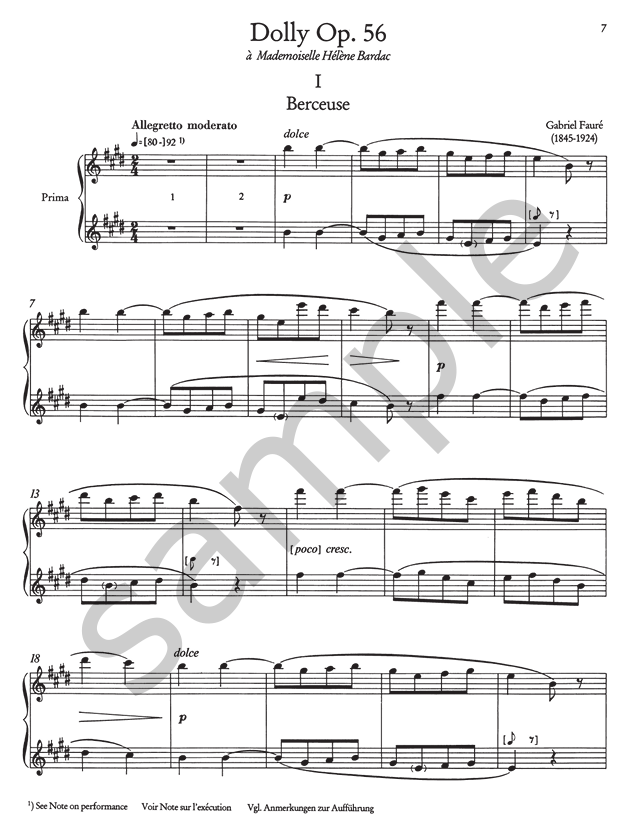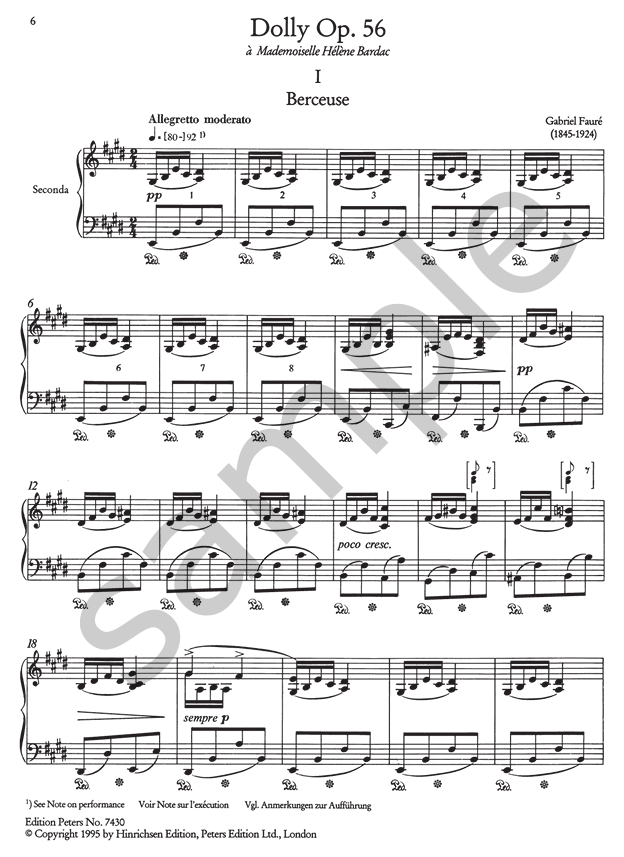
Happy Present Meet
Faure Dolly Op.56 for Piano 4 Hands
포레 돌리 모음곡
Berceuse Op.56, No.1
Mi-a-ou Op.56, No.2
Le Jardin de Dolly(The Garden of Dolly) Op.56, No.3
Kitty-Valse(Kitty-Waltz) Op.56, No.4
Tendresse (Tenderness) Op.56, No.5
Le Pas Espagnol(The Spanish Dance Step) Op.56, No.6
Fauré would have been delighted to know that this edition corrects the misguided feline associations in the titles for the second and fourth of these pieces. 'Mi-a-ou' should always have been known as 'Messieu Auol' (reflecting an infant pronunciation of the eponymous Dolly's older brother, Raoul), and 'Kitty-Valse' should have been 'Ketty-Valse', inspired ironically not by a cat but by the family dog! For such a cornerstone of the repertoire, Roy Howat - who personally knew Dolly Bardac, the suite's dedicatee - finds a surprisingly high number of source discrepancies to evaluate in the comprehensive critical commentary, including an indication that Fauré conceived the famous opening 'Berceuse' at a more flowing tempo than has become habitual over the decades. Based on his intimate knowledge of Fauré, he also urges the performers to keep rubato to a minimum, and keep the pedalling light.Fauré's Dolly suite honours Hélène Bardac (1892-1985), second child of Fauré's close friend Emma Bardac, the talented singer for whom he composed La bonne chanson. The infant Hélène's diminutive size, together with the contemporary anglomania, led to her being nicknamed "Dolly", and this remained with her throughout her life. Fauré presented this young girl with a lullaby for piano duet (the 'Berceuse'), possibly for her first birthday on 20 June 1893. Three more pieces followed: on her second birthday, on New Year's Day 1895, and on her fourth birthday in June 1896.The final two movements were added that autumn to complete the suite on 17 November 1896. In fact the 'Berceuse' had been composed 30 years earlier, when Fauré was eighteen, for Suzanne Garnier, the young daughter of a family friend in Tarbes.
포레는 이 판본이 두 번째와 네 번째 작품의 제목에서 잘못된 고양이 관련성을 바로잡았다는 사실을 알았더라면 매우 기뻐했을 것입니다. 'Mi-a-ou'는 원래 'Messieu Auol'(동명의 돌리의 오빠인 라울의 유아 발음을 반영한 것)로 불렸어야 했고, 'Kitty-Valse'는 'Ketty-Valse'로 불렸어야 했는데, 아이러니하게도 고양이가 아니라 가족의 개에서 영감을 받은 것입니다! 이 레퍼토리의 초석이 된 작품임에도 불구하고, 이 모음곡의 헌정자 돌리 바르닥을 개인적으로 알고 지냈던 로이 하왓은 포괄적인 비평에서 놀라울 정도로 많은 출처 불일치를 발견했는데, 그중에는 포레가 유명한 도입부 'Berceuse'를 수십 년 동안 습관적으로 사용했던 것보다 더 유려한 템포로 구상했다는 지적도 포함되어 있습니다. 포레에 대한 깊은 이해를 바탕으로, 그는 연주자들에게 루바토를 최소화하고 페달링은 가볍게 하도록 독려합니다. 포레의 '돌리 모음곡'은 포레의 절친한 친구이자 재능 있는 가수였던 에마 바르닥의 둘째 딸 엘렌 바르닥(1892-1985)을 기리는 작품입니다. 엘렌은 어린 시절 체구가 작았고, 당시의 영국적 열광과 더불어 "돌리"라는 별명을 얻었으며, 이 별명은 평생 그녀에게 남았습니다. 포레는 이 어린 소녀에게 피아노 이중창을 위한 자장가('자장가')를 선물했는데, 아마도 1893년 6월 20일 그녀의 첫 번째 생일을 축하하기 위한 것이었을 것이다. 그 후로 세 곡이 더 있었는데, 두 번째 생일, 1895년 새해 첫날, 그리고 1896년 6월 네 번째 생일이었다. 마지막 두 악장은 그해 가을에 추가되어 1896년 11월 17일에 모음곡을 완성했다. 사실 '자장가'는 30년 전, 포레가 열여덟 살이었을 때 타르브에 있는 가족 친구의 어린 딸인 수잔 가르니에를 위해 작곡되었다.
편곡자 Howat, Roy
작곡가 Faure, Gabriel (1845-1924)


Schumann Pictures from the East Op.66 for Piano 4 Hands
Mozart Piano Concerto No.12 in A major K.414 for 2 Pianos 4 Hands
Lydian Album for Violin, Cello and Piano
Chopin Preludes for Piano Solo (Paderewski)
파데레프스키편 제3권 : 쇼팽 발라드 (Paderewski : Chopin Ballade)
Shostakovich Concertino Op.94 for 2 Pianos 4 Hands
Chopin Etudes for Piano Solo #02 - National Edition (ed. J. Ekier)